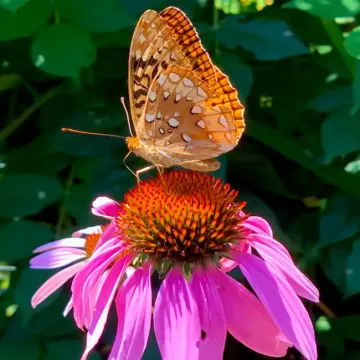Coneflowers, my preferred blooms, draw bees and butterflies. They're perennials, reliably returning each year. Their blooming season is lengthy, and they remain fresh as cut flowers for an extended period.
Known scientifically as Echinacea, coneflowers are dynamic, daisy-like perennials cherished in many gardens for their striking beauty and resilience. These flowers feature prominent, cone-shaped centers encircled by vivid petals available in purple, pink, white, orange, and even green in recent hybrid forms. Typically, the plants reach 2 to 4 feet in height and spread 1 to 2 feet wide. Their robust stems and ability to withstand drought render them ideal for a variety of garden conditions.
Native Range
Coneflowers are native to the central and eastern regions of North America, particularly in the prairies and open woodlands. They thrive in the wild in these areas, growing in sunny, well-drained soils.
Bloom Season
Coneflowers are summer bloomers, with their flowers typically appearing from early summer to early fall. Their long blooming season makes them a valuable addition to gardens, providing color and interest for several months. Deadheading spent flowers can encourage more blooms.
History and Uses
The name "Echinacea" comes from the Greek word "ekhinos," meaning hedgehog, which refers to the spiny central cone of the flower. Native Americans were the first to use coneflowers medicinally. The roots and leaves were used to treat various ailments, from wounds to infections. Today, coneflower extracts are widely used in herbal remedies, particularly in products designed to boost the immune system and alleviate cold symptoms.
Aside from medicinal uses, coneflowers are popular in garden design. Their bold, upright growth habit makes them perfect for perennial borders, pollinator gardens, and wildflower meadows. They are also often used as cut flowers due to their long vase life.
Native Varieties vs. Hybrids
The native species of coneflowers, such as Echinacea purpurea (purple coneflower), are cherished for their natural beauty and ecological value. Native varieties are particularly beneficial for local pollinators, such as bees and butterflies. They have single, open flowers, making it easy for pollinators to access the nectar.
In recent years, plant breeders have developed numerous hybrid varieties that come in a wide range of colors and forms. While these hybrids offer a broader aesthetic appeal, some, especially those with double flowers, can make it difficult for pollinators to reach the nectar. Gardeners who wish to support local wildlife should consider planting native species or hybrids with single, open flowers.
Caring for Coneflowers
Coneflowers are generally easy to care for, making them a great choice for beginner and experienced gardeners alike. Here are some tips for growing them successfully:
- Sunlight: Coneflowers thrive in full sun but can tolerate partial shade. Aim to provide at least six hours of sunlight per day.
- Soil: These plants prefer well-draining soil and can tolerate a range of soil types, from sandy to clay, as long as there is good drainage. Avoid waterlogged areas, as this can lead to root rot.
- Watering: Once established, coneflowers are quite drought-tolerant. Water young plants regularly until they are established, then reduce watering to occasional deep soakings during dry periods.
- Fertilization: Coneflowers are not heavy feeders. In fact, too much fertilizer can lead to floppy growth. If necessary, a light application of compost in the spring can give them a boost.
- Deadheading: Regularly removing spent blooms can prolong the flowering season and encourage the plant to produce more flowers.
- Pruning: In the late fall or early spring, cut back the old stems to the ground to encourage new growth.
- Winter Care: Coneflowers are hardy perennials that can survive winter in most climates. In colder regions, a layer of mulch can help protect the roots from freezing temperatures.
Top Varieties of Coneflowers
- Echinacea purpurea ‘Magnus’: A classic native variety with large, bright purple-pink petals and an orange-brown central cone. This variety is a favorite for pollinators and is very reliable in the garden.
- Echinacea purpurea ‘Fragrant Angel’: A white-flowering variety with the same strong growth habit as the native purple coneflower. Its crisp white petals make it a stunning addition to any garden.
- Echinacea ‘Green Envy’: This hybrid has unusual green-tinted petals with pink centers, offering a unique twist on the classic coneflower look.
- Echinacea ‘Cheyenne Spirit’: This vibrant mix of colors, including red, orange, yellow, and purple, brings a splash of color to the garden. It’s a hybrid that has gained popularity for its stunning range of hues.
- Echinacea ‘Double Decker’: A unique variety that features a double row of petals, with a smaller set of petals growing atop the central cone. This unusual look adds interest to the garden, though it may be less attractive to pollinators.
- Echinacea ‘PowWow Wild Berry’: This compact variety produces bright, rosy pink flowers on sturdy stems. It’s a long-blooming variety that’s excellent for containers and smaller gardens.
Coneflowers are a versatile and resilient addition to any garden. Whether you choose native species for their pollinator-friendly blooms or opt for colorful hybrids to brighten your landscape, these plants offer both beauty and benefits. With minimal care, you can enjoy their vibrant flowers all summer long while also supporting local wildlife.

